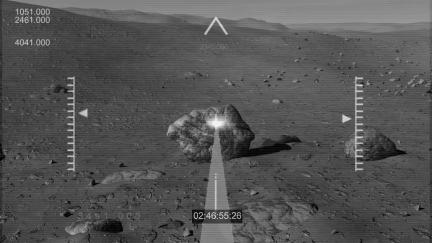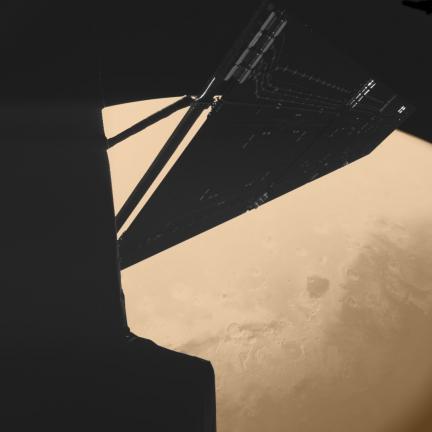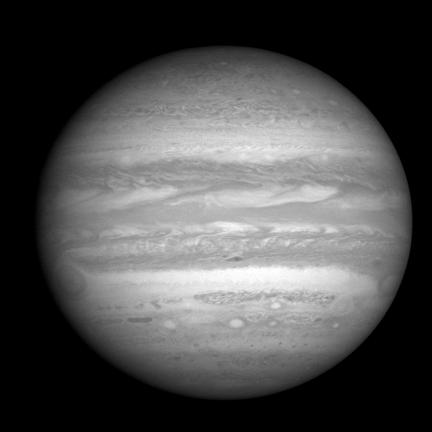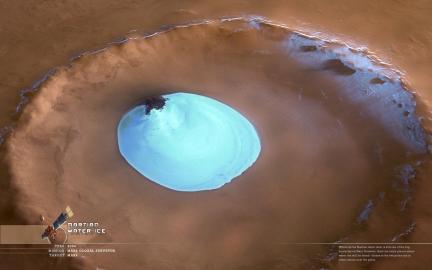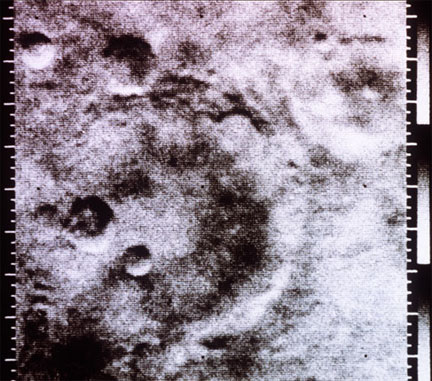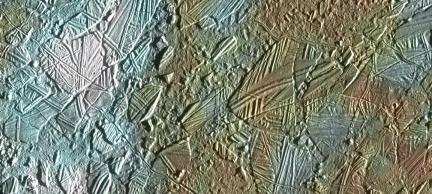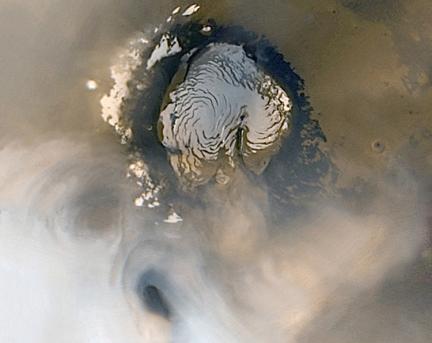 Phoenix Lander ready for launch tomorrow. Its destination is the Martian Arctic Pole, hopefully realizing the hopes of the lost Mars Polar Lander. See website for news.
Phoenix Lander ready for launch tomorrow. Its destination is the Martian Arctic Pole, hopefully realizing the hopes of the lost Mars Polar Lander. See website for news.
Martian Dust Devil as Seen from Orbit
What Might the Dust Storm Look Like on Mars?
 The above image was generated by “hortonheardawho” for unmannedspaceflight.com and represents some of the earlier days of the Martian dust storm currently enveloping the planet. This is Mars as seen from the Opportunity Rover who seems to be suffering under the storm worse than Spirit on the opposite side of the globe. While these skies are somewhat dark take a look at what it might have looked like around July 15 (or Martian day #1235 of the mission since arriving).
The above image was generated by “hortonheardawho” for unmannedspaceflight.com and represents some of the earlier days of the Martian dust storm currently enveloping the planet. This is Mars as seen from the Opportunity Rover who seems to be suffering under the storm worse than Spirit on the opposite side of the globe. While these skies are somewhat dark take a look at what it might have looked like around July 15 (or Martian day #1235 of the mission since arriving).
Using an image developed by Jim Bell to show the relative brightness of the dust storm at Opportnity’s position, the above image was artistically re-interpreted to show what that same scene might have looked like a few weeks later. The rovers have since been shut-down almost completely to try and conserve power and word has it that at present it is even darker than suggested here. The loss of light reaching the surface of Mars at Opportunity’s position is currently more than 99% and should these storms go on for too long the rovers will run out of energy with no light reaching their solar panels and that would finally spell the end of these long-running missions. Even though all operations that use any kind of power have been shut-down, the rovers do need to constantly use enough power to stay warm. As of this time, there is so little energy being replenished that just running the heaters is using up more energy than can be regenerated from the solar collectors.
While the situation does seem dire, most specialists expect the rovers to make it through this situation and expect to carry on after the storm dissipates. Coincidentally, Opportunity was just about to enter the Victoria crater and thankfully it had not as that would have surely spelled doom for that mission. The solar energy collectors would not only have had to deal with the low-light situation, but would have suffered under crater wall shadows as well.
Old Tyme Mariner 6 Film Reel
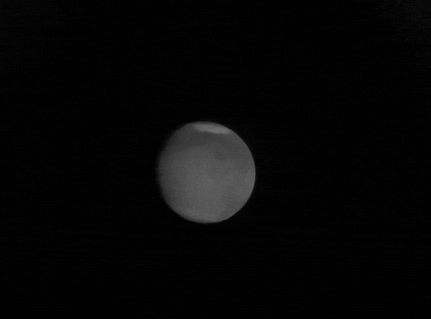 Similar... no?
Similar... no?
Old Tyme Mariner 7 Film Reel
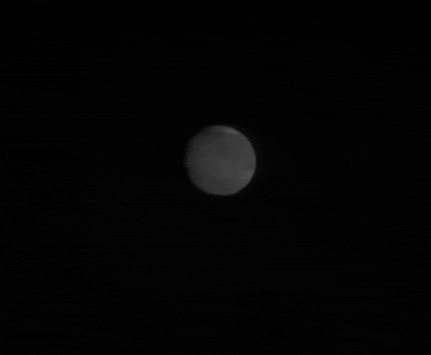 Ted Stryk, over at unmannedspaceflight.com (see “imager portfolios” in the right hand column), performed some handy work on these old Mariner 7 images on its approach to Mars. After the image clean-up work was completed he posted the files for download on the forum and wanderingspace worked the animation so that the trip to Mars would appear smoother. The result is very much as Ted describes as having, “a turn-of-the century nickelodeon look”, which is a pretty cool effect for an actual trip to Mars clip.
Ted Stryk, over at unmannedspaceflight.com (see “imager portfolios” in the right hand column), performed some handy work on these old Mariner 7 images on its approach to Mars. After the image clean-up work was completed he posted the files for download on the forum and wanderingspace worked the animation so that the trip to Mars would appear smoother. The result is very much as Ted describes as having, “a turn-of-the century nickelodeon look”, which is a pretty cool effect for an actual trip to Mars clip.
Mariner 7 was launched in March of 1969 and arrived in August of that same year. Shortly before arriving a battery exploded on board Mariner 7 and despite this near disaster, the Mariner team managed to get the spacecraft in fine working order just in-time for the encounter. A sister craft, Mariner 6, had flown by Mars only days before 7’s encounter and I intend to take a shot at arranging those frames for animation as well.
The Mars Laser and the Future of Space Exploration
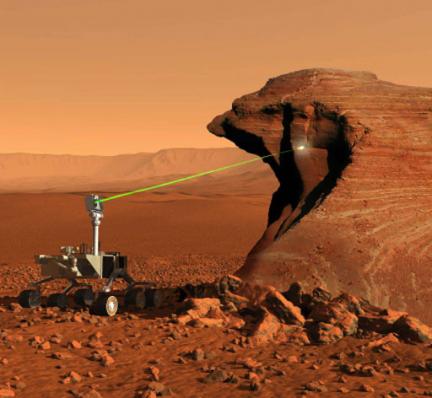
The coming Mars Science Lab mission will be employing a most unusual device for examining the surface of another planet. When MSL reaches Mars around 2010 it will be rolling about the surface of Mars zapping rocks and soil with an on-board laser beam generator. The beam is part of a science package that practices laser-induced breakdown spectroscopy, or LIBS for short. First, scientists on the ground will determine which objects or features imaged with normal on-board cameras seem worthy of further examination. Once a target is selected, a beam is generated and focused upon a small area of that target. This will burn or superheat the material into a plume of particles that expands at supersonic speeds as it cools. It is at this cooling time that the spectrometer will image the cloud and use the widest range of electromagnetic wavelengths possible — from infrared light through visible light and all the way to the ultraviolet. Since every element we know of has a signature of some wavelength within that wide range, the spectrometer will be able to determine all the materials present in the sample (even to simple trace amounts) by detecting and imaging the specific wavelength signatures present in the cloud.
What is most exciting about the instrument is that it is yet another example of NASA really employing non-traditional methods of exploring space. Gone are the old flyby probes of the 70’s and 80’s that simply pick a target and speed by with 95% of its mission goals completed in hours. So far this decade, NASA has chased a comet and collected comet dust in a grid of aerogel; intentionally slammed a heavy probe into a comet to form a man-made crater; they delivered 2 rovers to the surface of Mars that got there from a bounce landing; performed an impromptu landing of a non-lander type probe on the surface of an asteroid and now we will be shooting rocks on Mars. It provides us hope that once we are through the current financial speed bump of retiring the Shuttle fleet and completing our International Space Station commitments we can expect some really exciting new missions to our extended Solar System family. Some have already suggested such missions like air-probes on Mars and Saturn’s Titan; more aerogel collector type missions at Saturn’s Enceladus to collect geyser dust and most exciting of all would be a tunneling probe that could melt its way through the icy crust at Jupiter’s Europa in order to release a submarine type probe into Europa’s vast underground ocean.
It is stunning when you consider the near perfect scorecard for NASA’s unmanned space missions in the last 10-15 years and yet the organization is currently saddled with the image of being ineffective, stodgy and even sloppy. All these perceptions are coming from the manned side of its operations which hasn’t really done anything inspirational since apollo and the initial shuttle years. If only NASA was able to transfer some of the bold ambitions of the unmanned wing of its operations to the manned side of things, then maybe this image could just go away. I propose that even with the occasional tragedy and loss of life (which is inevitable on such endeavors) people would be much more accepting of such losses if astronauts died in the pursuit of doing something remarkable like going to Mars or even the moon for a second time. I mean, who wants to die so that we might hand deliver another component to the space station?
It is high time for us to be inspired by something again… on a grand scale. Time to focus at least some of our attention on something other than the fear of being blown up by terrorists or waging another war on a culture we know so little about. It is truly time to forget about Paris Hilton, forget about reality television and all the other pointless distractions that keep us from dreaming. In many ways it is bigger than just doing science in space — we need to give the next generation something better to think about. Something so exciting that the trivialities of the day that seem to dominate the national consciousness will at least be challenged by something so great that it will be hard to ignore.
We need to get going.
My Sci-Fi Bookcover Past II
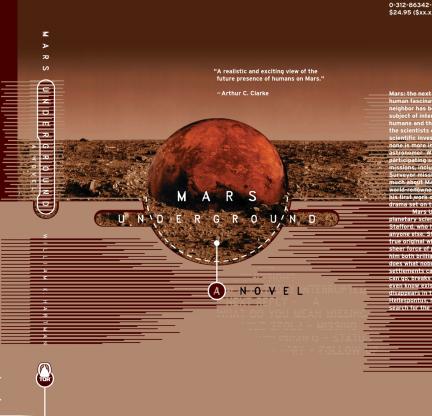 Scored another one. This time it is hi-res and I think this came out around 1996. I also just happened to get a copy of “Mars Underground” (unrelated) on DVD just yesterday which is about Zubrin’s “Mars Direct” concept of getting men (and women!) on Mars. I am thinking perhaps now this may finally be embraced as NASA’s Mars 2.0 plan going forward?
Scored another one. This time it is hi-res and I think this came out around 1996. I also just happened to get a copy of “Mars Underground” (unrelated) on DVD just yesterday which is about Zubrin’s “Mars Direct” concept of getting men (and women!) on Mars. I am thinking perhaps now this may finally be embraced as NASA’s Mars 2.0 plan going forward?
Wallpaper: Deuteronilus Mensae on Mars
 It is believed that these valleys may have originated from flash flood waters which came from melting ice many ages ago. But the conditions on Mars do not allow water to stay liquid for very long. That water would have frozen pretty quickly and then flowed down any depressions… which when you think of it - sort of makes an “instant glacier”.
It is believed that these valleys may have originated from flash flood waters which came from melting ice many ages ago. But the conditions on Mars do not allow water to stay liquid for very long. That water would have frozen pretty quickly and then flowed down any depressions… which when you think of it - sort of makes an “instant glacier”.
Telescopic Views of Our Moon and Other Planets
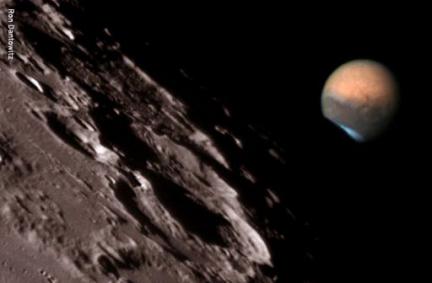
I stumbled across an image of Mars and our moon a while back, either on Universe Today or just from looking for great images of Mars on google. Anyway, it never occured to me that you can get such great detail of Mars while still being able to see a limb of the Moon in the same view. I thought it was a Photoshop job until I looked up “occult+Saturn+moon” and found similar images. For some reason, Jupiter images are more a rarity. What is unmistakable is that the above Moon/Mars image by Ron Dantowitz is pretty incredible for its clarity and detail.
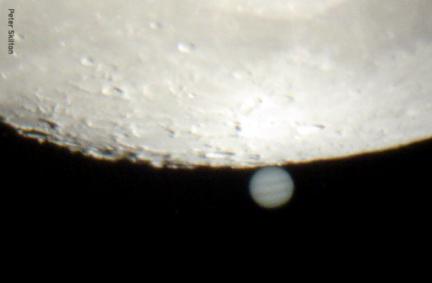

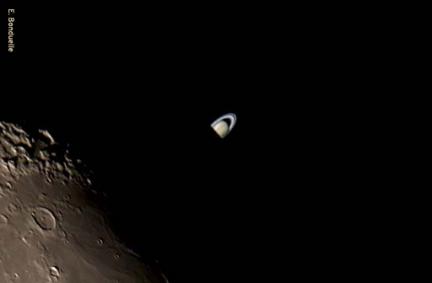
I couldn’t find any of the moon and a tiny blue dot of Uranus, but you can always use your imagination.
U. Gordan just sent me one of Venus too

Mars Science Lab Animation
 The coming Mars Science Lab mission video is available with various resolution options here (they are also downloadble!). This animation doesn’t focus as much on the trip to Mars as the MAAS ones have in the past, I would imagine that NASA wanted to highlight all the advanced science this mission will be performing instead of focusing on the long cruise to get there.
The coming Mars Science Lab mission video is available with various resolution options here (they are also downloadble!). This animation doesn’t focus as much on the trip to Mars as the MAAS ones have in the past, I would imagine that NASA wanted to highlight all the advanced science this mission will be performing instead of focusing on the long cruise to get there.
Take a look especially at the part of the mission where apparently they actually shoot a laser beam at various targets and take measurements of, what I would imagine, are the gasses emitted from such a burn. It also illustrates the process by which MSL will be taking soil and rock samples for in-depth investigations. This mission is exactly what it claims to be… a roving Science Lab on Mars. This is as close to having astronauts on the surface as our current technology can allow… that is… without actually sending someone… which our current technology does allow.
WTF?
I just updated this post with a higher resolution image of this hole in Mars. Click on the image for an even higher resolution version.
The darkness of this hole in Mars is not due to limitations of the cameras. The Mars Reconnaissance Orbiter is usually always able to detect details even in dark shadow. But blowing this image out to reveal details shows nothing. No side walls, no bottom… leading most to consider that this is a sinkhole that fell into a large Martian cavern. Most likely the total lack of detail probably means that the surface around this hole is actually over-hanging a deep pit.
Maybe this is where all the ancient running Martian water drained to. Better watch your step.
Lots of Water on Mars
The top image shows the radar imaging of underground structures on Mars, below that is the typography of that same region and the radar swath is represented by the white line that cuts through it.
In the radar image, the point at which the traces or “layers” split into two (on the left side) is where it is thought that the materials change and so the radar is echoing again off that lower subsurface. They also add that “the strength of the lower echo suggests that the intervening material is nearly pure water ice”, which apparently may translate into a depth of 3.5 kilometres of ice. This image is not alone, additional radar scans have suggested ice that runs to a depth of 1.5km in other places with surely many more to come.
It would seem that the intended purpose of finding where, or if, water exists on Mars has more or less been satisfied. I don’t think that anyone expected to find this much evidence of water on Mars between the recently discovered water flows and now a nearly planetwide (theoretical) underground reservior of pure water ice. Future astronauts on Mars will not go thirsty!
Wallpaper: Mars Sunset Over Husband Hill
 This is another fine example of freelance imagers at work. Many of whom spend time at unmannedspaceflight.com.
This is another fine example of freelance imagers at work. Many of whom spend time at unmannedspaceflight.com.
Rosetta at Mars
This gorgeous true color full globe of Mars may become the definitive Mars portrait image for the planet. For those may not have noticed, I have tried to apply a “portrait” label on at least one image per body as being the best representative full globe image of that world. The image I currently have tagged for Mars is that great image of Valles Marineris cutting across a near full disc of Mars taken by Viking.
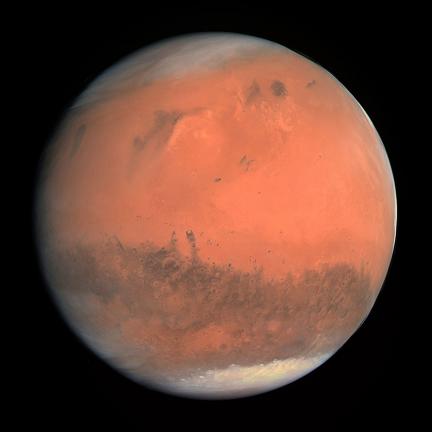
Also worth posting is this semi-color image of Mars seen from behind the solar panels of the probe itself. It was taken by the lander attached to Rosetta which will one day detach itself from the parent probe and make an attempt to actually land on the surface of comet 67P/Churyumov-Gerasimenko in 2014. It looks as if it was originally a black and white image and someone at ESA just applied a color tone to the Mars globe, although I could be wrong.
2 Missions Swing by 2 Planets
The month of February is treating us to two gravity-assists and a chance to do some observations on the way to their primary objectives. On the 25th the ESA Rosetta probe, on its way to a comet Churyumov-Gerasimenko landing in 2014, will swing by Mars and momentarily join the gaggle of various probes currently studying Mars. Still a small disk in its view, this is how Mars looks to Rosetta set against the Milky Way.
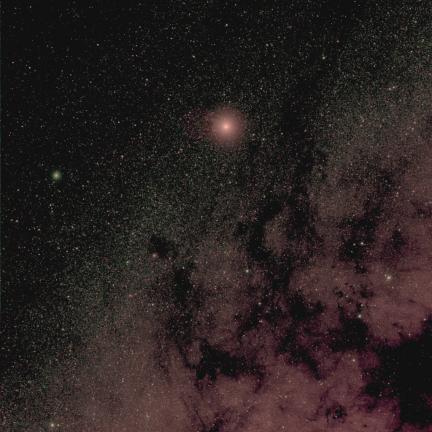
Then on the 28th, New Horizons on its way to Pluto will swing by Jupiter and conduct the first up close observations of the gas giant since the demise of Galileo. Jupiter at current already fills New Horizon’s full view.
Phoenix: Failure Avoided
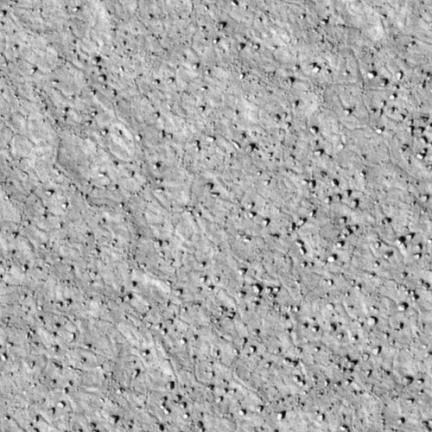
The above image was returned to the team assigned the task of selecting a landing spot for this summer’s launch of the Phoenix lander. This has been considered for years and once the Mars Reconnaissance Orbiter was placed in orbit around Mars, one of it’s highest priority tasks was the image this proposed area. As you can see, what was previously thought to be a fairly flat safe place to put down a lander has turned out instead to be littered with boulders that compare in size to the lander itself. Many missions to Mars in human history have ended in failure, especially when including the many Russian probes which were lost to various problems. Attempting to touch down in this area could certainly have spelled doom for the Phoenix lander and we would never have known without the high resolution eyes of the Mars Reconnaissance Orbiter.
Maybe NASA would have gotten lucky again, but this looks to many as a disaster avoided.
Wallpaper: Martian Water Ice
Another Amazing Animation from Maas Digital
 If you have never seen the incredibly real animation of landing a Mars rover on Mars made by the people at MAAS Digital, you have to see this. Normally these computer generated animations are hardly real not only in look, but the physics usually feel quite fake as well. NASA finally got around to finding someone who could turn around a truly real animation of what landing on Mars actually looks and feels like. When stages drop and seperate you really get a sense of it. When the MER air bags inflate and bounce to a resting stop, you would swear there was a camera on the ground to capture the process.
If you have never seen the incredibly real animation of landing a Mars rover on Mars made by the people at MAAS Digital, you have to see this. Normally these computer generated animations are hardly real not only in look, but the physics usually feel quite fake as well. NASA finally got around to finding someone who could turn around a truly real animation of what landing on Mars actually looks and feels like. When stages drop and seperate you really get a sense of it. When the MER air bags inflate and bounce to a resting stop, you would swear there was a camera on the ground to capture the process.
 Now the same masters at MAAS Digital give us a preview of what the Mars Phoenix Lander will hopefully be successfully executing in May of 2008 when it lands on the Martian surface. I didn’t get a chance to see the incredible MER animation until well after the mission was already operating at Mars, so it’s nice to see this well before the mission is even launched to get a sense of what is to come.
Now the same masters at MAAS Digital give us a preview of what the Mars Phoenix Lander will hopefully be successfully executing in May of 2008 when it lands on the Martian surface. I didn’t get a chance to see the incredible MER animation until well after the mission was already operating at Mars, so it’s nice to see this well before the mission is even launched to get a sense of what is to come.
Life in the Hood: Mars
While most scientists are more excited by some of the possibilities that Europa may offer, the next most likely place to find some kind of life is still Mars. Even after all the landers, rovers and orbiting observers, Mars still keeps dropping hints that there may still be some kind of rare environs in a few places where any life that may have once flourished could still have survived these many millions of years since the planet dried up. Just last week the first direct evidence of liquid water moving across its surface was presented at a special news conference based upon the observations of the now defunct Mars Global Surveyor (see wallpaper image below). Perhaps whatever small amount of underground water still exists on Mars still plays host to some simple forms of life which have adapted and learned to also go to where the water went, which seems to be underground.

Most expect that if we ever find anything hopeful on Mars it will be in the form of a fossilized record. Many doubt that life on Mars is current and the assumption is that the odds are highly in favor of Mars having once been a habitable place many, many years ago when it was much wetter. There is a huge amount of evidence on that presents us with what looks like a once saturated landscape of rivers, lakes and even oceans. Had this been the case, it seems very likely that Mars may have once given rise to life on its surface and if it did – there would likely be a vast geological record of these organisms left behind.
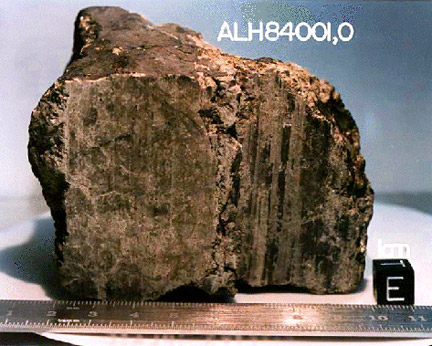
In a related story… once in a while an Antarctic meteorite remnant is found that turns out to be one of a very rare kind which scientists are now sure are of Martian origin (they have 12 of these actually). They know this because when they drill into these meteors and find small bubbles of gas exist (as they do in most rocks) that contain almost the same exact composition of gasses that are found in the atmosphere on Mars. Leaving us with the conclusion that they must be of Martian origin as the coincidental likelihood of a rock left over from the formation of the Solar System having trapped gasses which exactly match that of the Martian atmosphere is extremely thin – if not impossible. The theory goes that some colossal impacts took place on Mars which scattered debris largely on the surface, but left a few chunks flying so fast and furious at the right speeds that they not only escaped the Martian atmosphere, but even the gravitational pull of Mars itself. Whereas they are left to wander the solar system for potentially millions of years until a chance encounter with the Earth results in an all-natural cosmic sample return mission from Mars.
 In the 90’s a paper was published in Science magazine that proposed the discovery of the first organic compounds to be found in a Martian meteorite. Furthermore, the authors of this paper observed that there may be mineralogical features that may be fossil evidence of ancient Martian organisms (see left). Excitement on this finding was high and the impact of its meaning went as high as the President of The United States making a specific statement on it at a news briefing, after all, it would be the first evidence of life outside of Earth to have ever been detected. Since that exciting time, many scientists have come out to refute each of the individual findings and have stated that they each could have each come from processes which were non-biological. However, the paper’s authors still contend that circumstances are far too coincidental and that “when considered collectively… we conclude that [these phenomena] are evidence for primitive life on early Mars”.
In the 90’s a paper was published in Science magazine that proposed the discovery of the first organic compounds to be found in a Martian meteorite. Furthermore, the authors of this paper observed that there may be mineralogical features that may be fossil evidence of ancient Martian organisms (see left). Excitement on this finding was high and the impact of its meaning went as high as the President of The United States making a specific statement on it at a news briefing, after all, it would be the first evidence of life outside of Earth to have ever been detected. Since that exciting time, many scientists have come out to refute each of the individual findings and have stated that they each could have each come from processes which were non-biological. However, the paper’s authors still contend that circumstances are far too coincidental and that “when considered collectively… we conclude that [these phenomena] are evidence for primitive life on early Mars”.
The jury is still out.
Life in the Hood: Europa
There are two schools of thought in the world on extra-terrestrial life coming from people who think seriously of such things. One is that the universe is teeming with life, yes… teeming. A good majority of folks these days think the universe is lousy with life forms. The second theory is that here on Earth life is a rare and possibly singular event. Either of these conclusions are quite a leap of faith for lack not only of evidence, but for opportunities to even discover any of the evidence needed to support either assertion. You see, the universe is spread out in a big way. It takes light from Earth a bit over 4 years to reach the nearest star to our sun Alpha Centauri, meaning that any astronomers at Centauri who might be peering out in our general direction see us as we were 4 years ago. So if it takes light that long to get to our nearest neighbor, you can imagine how long it would take our fastest, newest spacecraft to reach there. Using technologies not even mature enough to consider actually using, it still could take us 40+ years just to reach that nearest star… and that’s probably a liberal estimate. So apart from someone developing a hyper-warp drive which can surpass the speed of light (which they tell me is not only impossible but pose an awful lot of other difficult circumstances) or someone at SETI (Search for Extra Terrestrial Intelligence) picks up a faint and 25 year old signal coming from Vega (see the film Contact for reference), it would seem for the time being we are stuck having to search our own neighborhood.
About 30 years ago the outlook for life in our own solar system seemed bleak. The moon was as desolate as one could imagine and Mars when spied by Mariner 4 for the first time, up-close (see above), shocked and disappointed many with a surface that seemed more akin to our moon than with Earth. Gone were all the dreams of Martians directing canals to their great cities or even the hope of a Mars rat scurrying across the red dunes. In addition to this, the assumption was that the rest of the Solar System was hopelessly cold and unworthy of hosting even the smallest of microbes. The gas giants were surface-less hostile environs, most bodies lacked breathable air of any kind and Venus was so hot it would immediately fry anything hoping to eek out a living on its surface. Finally, after the Viking landers determined Mars to be lifeless in the 70’s (in what many now call a flawed experiment) most gave up hope and began seeing the Solar System as nothing more than a place filled with mostly cold lonely destinations offering mankind little more than an ultimate challenge of survival away from home. That was until Voyager sped by Jupiter and its moons a few years later and a small world most have never even heard of, named Europa, held out a glimmer of hope to those in the know.
After returning the first images of Europa’s surface riddled with ridges, cracks and what looked like considerable geological activity (see above wallpaper, actually taken by the Galileo not Voyager) many began to speculate these features must be the result of a vast underground ocean which causes stress on the outer “shell” and causes it to crack. This theory was propped up further when Galileo arrived at Jupiter in the 90’s. Much better resolution images revealed much greater detail including what appeared to be “icebergs” in a large region that from a distance appeared to look like shattered glass. You could easily see where one “berg” broke off from another and floated a distance away by some means (see below). This makes many as sure of the underground ocean on Europa as you can get without actually drilling down through the icy crust and plunking down into the wet core.
So if we have a moon made largely of water ice, who is being internally heated by tidal forces coming from Jupiter, we can almost assume that much of this body would be melted ice as you move down from the rock-hard frozen surface toward the warm center… and… one can assume that somewhere in between hot in the middle and cold on the surface, there may be a large zone of warm waters as cool and warm as that found on any Hawaiian beach. Meanwhile here on Earth, we have found that life survives nearly any hostile environment from 200 degree heat vents of acid water on the ocean floor to microbes found frozen in Antarctica. The theory goes, if life survives in hell on Earth why not a comparable heaven on Europa?


